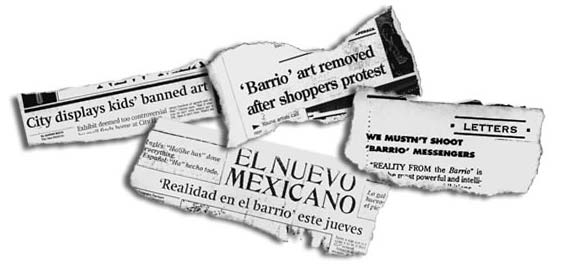
introduction
The news tip came in the afternoon of June 24,1994. A local shopping mall removed some "objectionable" artwork from a Santa Fe Boys & Girls Club exhibit it hosted called Reality from the Barrio. "Interesting,"I thought. "But it's not my beat. " Wrong. Censorship is everybody 's beat. And journalists, as society's self-appointed watchdogs, need to be especially vigilant against those who would stifle freedom of expression. After all, I reasoned, if it can happen to them, it can happen to us.
Wrong again. The reality —in the barrio as elsewhere —is that there is no "them" and "us." We're all in this together.
 I
drove to the Villa Linda Mall to see what all the hubbub was about. What
I discovered was a world I'd passed through every day but never really saw
—the barrio as experienced by some of its denizens. Stark, in-your-face
photographs of mostly young Chicanos —sometimes joyful, occasionally
angry, more often looking listless and bored —confronted me from a
network of crude scaffolding fashioned from old doors and window frames.
Portraits of family gatherings and children at play softened the hard edges
some. Shots of lovingly executed murals in arroyos and on buildings contrasted
sharply with impromptu I-was-here graffiti. Missing, however, was an essay
pondering the path not taken by its author, a 17-year-old former A-student
who joined a gang, flunked out of school, and turned to drugs "to keep
my mind off of how messed up my life had become." Empty spaces remained
where once hung photos of youths, and in some cases their elders, throwing
"family" (gang) signs. Nowhere to be seen were the paños:
handkerchief paintings modeled after those made behind prison walls, depicting
themes of love, religion, and gangs. A mall spokeswoman said she removed
about 20 items from the show after shoppers complained that they glorified
gangs. But it's not censorship, she said quickly, because the all is private
property. Besides, she added, Villa Linda Mall donated the space for the
exhibit.
I
drove to the Villa Linda Mall to see what all the hubbub was about. What
I discovered was a world I'd passed through every day but never really saw
—the barrio as experienced by some of its denizens. Stark, in-your-face
photographs of mostly young Chicanos —sometimes joyful, occasionally
angry, more often looking listless and bored —confronted me from a
network of crude scaffolding fashioned from old doors and window frames.
Portraits of family gatherings and children at play softened the hard edges
some. Shots of lovingly executed murals in arroyos and on buildings contrasted
sharply with impromptu I-was-here graffiti. Missing, however, was an essay
pondering the path not taken by its author, a 17-year-old former A-student
who joined a gang, flunked out of school, and turned to drugs "to keep
my mind off of how messed up my life had become." Empty spaces remained
where once hung photos of youths, and in some cases their elders, throwing
"family" (gang) signs. Nowhere to be seen were the paños:
handkerchief paintings modeled after those made behind prison walls, depicting
themes of love, religion, and gangs. A mall spokeswoman said she removed
about 20 items from the show after shoppers complained that they glorified
gangs. But it's not censorship, she said quickly, because the all is private
property. Besides, she added, Villa Linda Mall donated the space for the
exhibit.Shakespeare elegantly described censorship as "art made tongue-tied by authority." Despite good intentions, the mall indeed tied the tongues of the images it pulled. But it couldn't silence the creators.
At the risk of offending their patron —a familiar angst for artists across the centuries and cultures —the young exhibitors loudly decried what they considered an insult to the integrity of their work. Still, they managed to see irony in a situation where reality is just a little too real for some tastes.
"They shouldn't name the show Reality from the Barrio anymore," said 15-year old Rebecca Apodaca, whose photo, "Little Local," was among those removed from the show. "Gangs are a reality in the barrio." Boys and Girls Club director Al Padilla was more cynical. "Yeah, Les," he told photography director Leslie Alsheimer, "that 's reality for you. Welcome to the barrio."
 was
it censorship?
was
it censorship?
Alsheimer became deeply enraged —not at Padilla, but at his surrender.
"That’s what made me so angry and made me want to do something
about it," she told me later. The result is this book, a fine example
of how rage and passion can spawn creativity and a sense of purpose.
Do some of these pictures glorify gangsters? Perhaps. But that, too, is
reality in neighborhoods where gangs represent both escape and apotheosis
in the absence, or at least elusiveness, of other opportunities.
If the images disturb you, if you feel discomfort at the hostility and
anguish in some of the prose, this book will have fulfilled its mission
as a social documentary.
Reality isn't always pretty. But it 's all we've got. Look closely and
learn.
—Tamar Stieber, Journalist